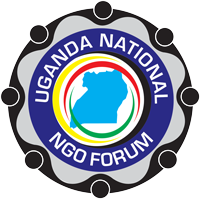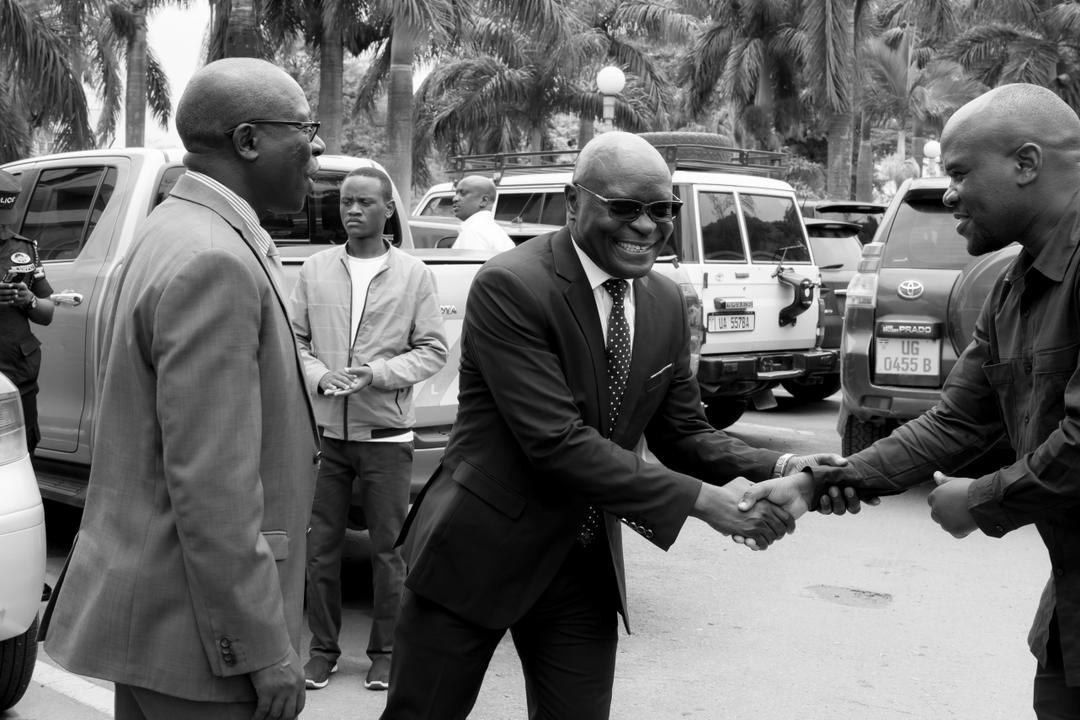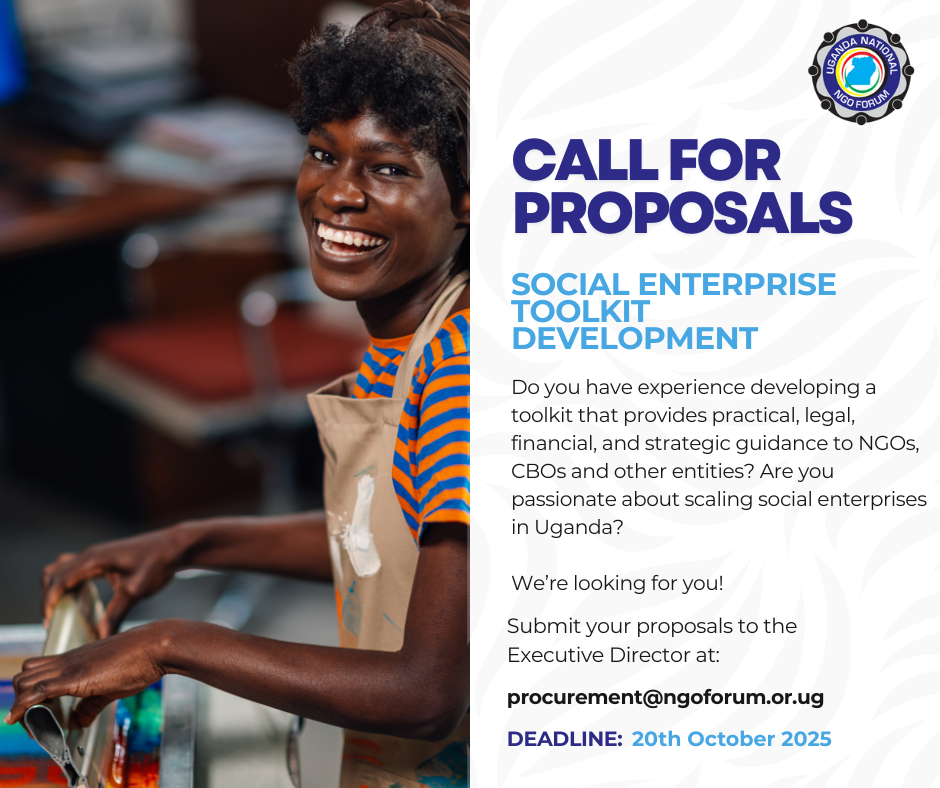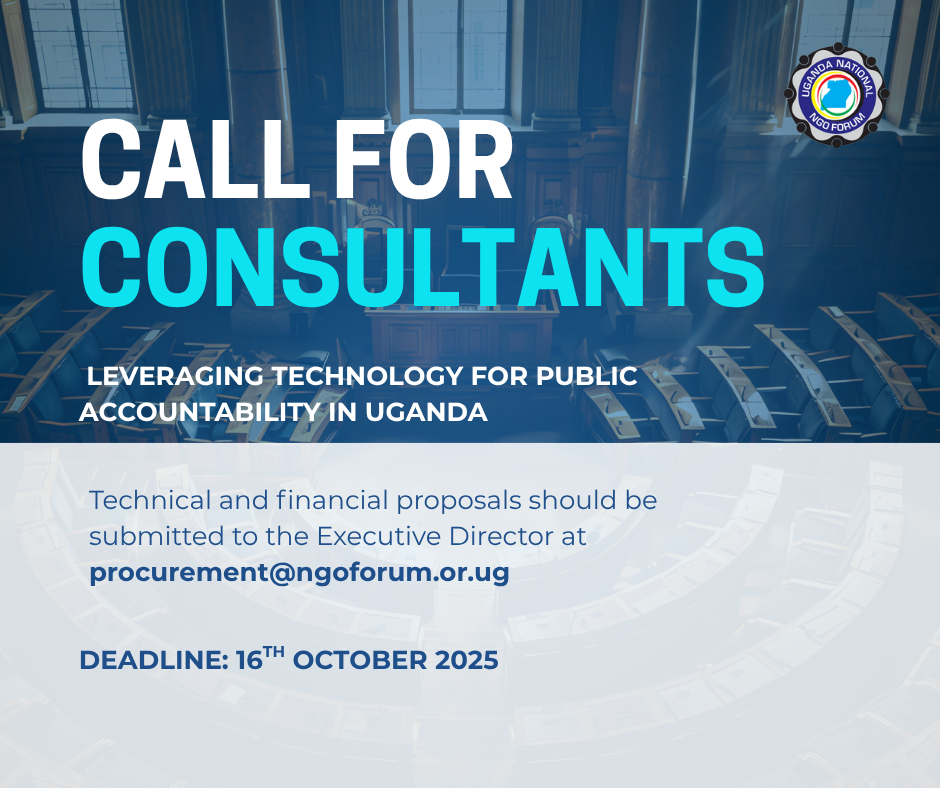Presentation at the 46th Session of the State of the Nation Platform Uganda@50: Content and Process towards a Charter on Citizenship
In October 2013 we started the journey of the next 50 years. As a country we are now in our midlife. We are therefore intellectually mature, we have lost some of our youthful shine, gained our maturity and are starting to anticipate our old age challenges. Uganda’s citizens have walked on the road from colonial rule, to post colonial rule, through dictatorship and promised democracy, movement systems and now multiparty system. Through the years, Ugandans have endured all forms of opportunities and challenges. At fifty one, Uganda stands with its head up, mature and ready to move into the centenarian club. As we move forward as a country, the question lingers on, how does the Ugandan citizen embrace this journey? My conclusion is that this journey has to be made with tact and tenacity. The ideas I present here are a preamble to the work that we have been doing this year on the Citizen Charter for Uganda.
 Just a word on definitions; in the public sector, charters are usually developed to ensure that administrative units are accountable and citizen friendly, they are transparent and ensure right to information and that a productive relationship is built between public servants and citizens. A charter therefore is about making sure that government bodies work in accordance with the citizens’ interests. In our case what we have developed is a demand side charter by citizens that represents a reclaiming of our dignity as citizens, and reenergizes our resolve to construct a better future for Uganda. The citizen charter in this case is therefore an exercise in building citizen agency to counter the years of civic deficit that we have had to endure as Uganda citizens. Let me turn briefly to a short description of the historical baggage and contemporary generational challenge that Ugandan citizens have to offload and negotiate (respectively) as the build momentum to building a better Uganda.
Just a word on definitions; in the public sector, charters are usually developed to ensure that administrative units are accountable and citizen friendly, they are transparent and ensure right to information and that a productive relationship is built between public servants and citizens. A charter therefore is about making sure that government bodies work in accordance with the citizens’ interests. In our case what we have developed is a demand side charter by citizens that represents a reclaiming of our dignity as citizens, and reenergizes our resolve to construct a better future for Uganda. The citizen charter in this case is therefore an exercise in building citizen agency to counter the years of civic deficit that we have had to endure as Uganda citizens. Let me turn briefly to a short description of the historical baggage and contemporary generational challenge that Ugandan citizens have to offload and negotiate (respectively) as the build momentum to building a better Uganda.
British colonial rule commenced with a treaty of protection with the Kabaka (King) of Buganda in 1894.[1] A colonial ruler “Lord” Lugard came in and offered “protection” to the King of Buganda. By 1921 colonial rule spread under the guise of “protectionism” against the war which had moved to other Kingdoms of Toro, Bunyoro and Ankole.[2] This initial pattern of colonial rule was built on the already existing centralized administrative hierarchy of the Buganda Kingdom. Control by the Kingdom was through the royals and hereditary appointees to the different regions of Buganda Kingdom. For rationalization and effective “protection” by the British, they chose to formalize their relationship by signing one of the watershed documents in the redefinition of the Ugandan state – The Buganda Agreement of 1900. The Buganda Agreement gave substantial grants of land and power of citizens to the ruling elites. The different clauses in this agreement gave the Chief the power to carry out a number of tasks. For example, Clause 9 of the Agreement specified the following tasks for the chief:
- Upkeep of the main roads,
- Assessment and collection of taxes
- Administering justice among the ‘natives’ (not citizens)
- General supervision of the ‘native’ affairs[3]
These new roles assigned to the chiefs came as a result of replication of indirect rule that Lord Lugard had seen succeeding in the Monarchies of India and Nigeria. The new institution of the chief as Mamdani reveals was a social construct of the colonialists. The chief’s multi-faceted roles meant that he had the power to enforce the new roles that came with the institution of colonial rule and even invent his own. Indeed as one German missionary noted, the chief ended up paying himself seven times more than the colonial Governor did! He got tributes like cattle, labor, meat, and beer in addition to what the colonialist was supposed to give him and even had the right to the third child of a family.[4] This social reconstruction had a lot to do with how citizens initially interacted with the colonial state in these early days. This tension continued into the independence period after Uganda got independence on 9th October 1962. Constitutional negotiations about the relationship of the Central government and the different local governments were some of the most contested issues.[5] The Independence Constitution that emerged was basically a compromise. This Constitution gave full federal status to Buganda but the control over the revenue sources and security of the Kingdom were not fully granted to the Kingdom.[6] The continued struggle of Buganda for more control of the police and revenue brought increasing strain on the political landscape of the country. These events culminated into the February 1966 dissension. In 1966 the Prime Minister accused the President and five other Ministers for conspiring to overthrow him. The Ministers were arrested and the army stormed the Kabaka’s Palace. The Kabaka escaped to Britain and Buganda was brought under the direct administration of the Uganda central state.
Fast foward – a short regime by Obote, was followed by Amin’s regime. This regime was marked by one memorable event that redefined the state of Uganda. Amin declared an “economic war” in Uganda and with this came the expulsion of all Asians from the country in which they were predominantly in the business class. They left in a hurry and took with them the business acumen they had accumulated over the years. During the Amin era, thousands of people entered business circumstantially when the President handed them free businesses. As a result, factories and companies closed down because of inexperienced managers or some who just took everything away and closed up. The economy was more or less kept going through informal efforts of citizens.[7] Taxation acquired an enigmatic character being applied to any one only when it suited the executing body.
All this ended with the coming of the National Resistance Movement (NRM) in 1986. The National Resistance Army/Movement (NRA/M), started by putting in place citizen-led governance institutions in the “liberated areas” of Uganda. These institutions came to be known as the Resistance Councils (RCs).[8] Citizens in the famous Luwero Triangle which was the bedrock of the NRM resistance rebel activities quickly organized themselves into RCs which were then very instrumental institutions that kept the war going through popular mobilization of local citizens to support the war, reconnaissance missions and keeping law and order in the areas under NRM rule.[9]
When the NRM took over power in Kampala in January 1986, the RCs then became the de facto institutions that were used to deliver social services and also help to restore law and order. As public confidence grew, so did the powers, which were being usurped by the RC leaders. The RCs therefore took over most of those roles which citizens considered were not being delivered by the past institutions of the chief. The first post 1986 inquiry into local governance[10] after the NRM took power in 1986, chaired by Professor Mahmood Mamdani stated that; ….it is important to state clearly whether the Resistance Councils and Committees are organs of the state, or organs of the National Resistance Movement or organs of the people, and to delineate their powers and functions.[11]
From 1986 to 1995, several policy experiments were tried and in 1995 a new Constitution was promulgated. This was seen as a very important document in defining citizen rights and responsibilities. In a bid to respond to the challenges of implementing the Constitution since 1995 Uganda amended its Constitution in 2005. Significant reforms emanating from this amendment process included; distinguishing Kampala as the capital city of Uganda, providing for Swahili as the 2nd official language of Uganda, providing for the leader of opposition in Parliament under Multiparty Political System and removing limits on the tenure of office of the President among others.
From this short narrative it is clear that at every turning point in Uganda’s history, be it in 1962, 1979 or 1986[12], it has been citizen engagement that has propelled the country forward and helped it conquer periods of peril. This was evident when Ugandans, with the help of the Tanzanian government fought and removed the brutal regime of late General Idi Amin Dada. It was also evident when Ugandans joined the National Resistance Army between 1980 -1985[13] to fight to overthrow the government of Milton Obote which stood accused of rigging the 1980 elections and of perpetrating gross human rights abuses. Citizens have been central to the struggle to construct the Uganda they want albeit under very hard circumstances.
Today this history represent moments of nostalgia and memories of horror. Brutality, resilience, empowerment and disappointment are all words that can be used to describe Uganda. The promise and parlance of the post-1986 government is one represents a moment of emerging challenges that the Uganda citizen needs to overcome. Let me briefly describe the critical challenges which stand in the way of reconstructing a citizen with dignity in Uganda.
This first challenge is the collapse and run down public services. This is a big challenge because for a citizen that pays taxes and votes leaders into power – that citizen of Uganda is getting a raw deal when one looks at the quality of services. This is not just an NRM regime phenomenon, but it is one that comes from years of deceptive government investments. The colonialist worried more about investing in extraction and extradition of natural resources and not development, the post colonial governments have spent all the time fighting to maintain their grip on power and not caring about the citizen. Today what we reap is a frightening collapse of public services that even the post-1986 government has failed to fix. Children continue to go to school and learn nothing and dropout of school. For instance we enroll 1.5 million children every year and we graduate 500,000 in primary seven after seven years. One million children fail to make it through seven years of schools. When we look at learning, our own research as civil society – under a citizen led assessment of learning code-named ‘Uwezo’ found that across the country eight out of ten children in primary three cannot do primary two work – meaning that they are below their levels of capacity for the grades. In the health sector, mothers continue to die on hospital floors with sixteen mothers dying every day from preventable complications. The poor roads continue to claim lives of numerous Ugandans with our statistics of carnage on roads rising dangerously.
This breakdown in public service delivery has meant that most services as now privatized – and citizens have to get them for a fee. Parents choose good education in private schools, citizens pay for most health care services, water is paid for, and those who can afford have to find a generator to substitute for the erratic electricity supply from the national grid. Everywhere we turn public services are under stress and for a price. This has left citizens that cannot afford in even more worse conditions. This is a development challenge that requires that we do everything it takes to fix the public service debacle.
The second big challenge is the worrying reality that all Ugandans – from Leaders to Peasants are ‘living on the edge’. Thisischaracterized by all kinds of vulnerabilities. The leaders do not want term limits because there is no security outside leadership, the peasant desperately ekes a life out of a rugged rural life because that is the only way to escape that poverty. Peasants dig with a hoe hoping against hope that one day and maybe one day it will change their lives and they will have food security. They accept everything that the next politician around the corner can offer because as we say in Uganda – ‘that is where life has reached’. A 500 shilling coin is enough to buy a vote, a glass of waragi (local gin) on election night is enough to drown the sorrows of a man and guarantee an empty life every five years.
While – we – the middle class – look on. We see both sides of the road. We look at scenes like the comfortable political and new-age electronic thief in government on one side and the desperate urban youth riding a boda-boda (like there is no tomorrow) and the desperate citizen rural folk who look on mesmerized by the elite gluttony and incomprehensible contradictions that surround our lives. The middleclass continues to ‘live on the edge’ in prayer (for the demon-chasing Christians) and in perplexity for the half-hearted opposition politicians that pulls a few camera friendly stunts, to the savvy NGO worker who continues to see a project in every crisis and we construct our own small worlds filled with Facebook, Twitter, DSTV and enjoying short spurts of modernity facilitated by donors funds. This is a generational challenge to all citizens of Uganda. This is a challenge that has no policy prescription. This challenge does not get seen by foreigners and indeed does not get treated.
What this requires is creating both public trust and citizen security. We should trust that this country can deliver to all of us and that indeed there will be human security, social security and democratic ownership in this country for generations to come. I invite you to reflect on this issue.
The third big challenge is the paradox of a very present government and very absent government. Yes! On the one hand, we are over governed from Local Council 1 – Local Council 5, Presidential Advisors, an army of Ministers and several other visible troops ‘serving’ the state. Currently we have about 2 million elected leaders at different levels of governance. Yet on the other hand, if you are looking for a supportive government it is not there. Avoidable diseases are killing people – death from Malaria, Maternal Mortality, Infant Mortality, Marburg Disease, Ebola let alone the rise of HIV (that even caused an opposition leader to defect!) – are all things to worry about. In fact, whenever there is a fire the fire-brigade is never on time, we gave up drinking water from water taps long ago. Yet on the other hand, government is present. If one ‘walked to work’ there is a heavy presence of government, if one protested theft of public funds publically there is government to tell you to protest indoors, police will always find enough numbers to deploy for hotly contested elections but never enough numbers to stop violence against women or child sacrifice. So while government is very absent in the world of social services, government is very present in the world of politics and security services. While in some parts of Uganda you walk 5 kilometers to find a policeman, in Kampala you walk 5 meters to find one. This absence and presence of government is making many wonder, where in the world we are going. This is a generation challenge to citizens.
Ladies and Gentlemen, how did we get to this position? We now stand on very slippery grounds wondering how we got ourselves to this position – to a position where donors are cutting aid, civil servant becoming ‘thieving servants’ and a host of other challenges. What happened? Why is the Pearl of Africa going around full circle from a country we thought was on the road to becoming a beacon of democracy to a country that can now be characterized as a failed state by a global report, a country where the arrests of parliamentarians, opposition politicians and human rights activists are becoming common place.
The answer seems to lie in the place that we as citizens can reclaim. What citizens, the allover world seem to be showing us, is that, if the world is going to change then people must become agents of their own development. This is easier said than done. But what it calls for is a radical shift in democratic thinking so that while we continue to celebrate and enjoy ‘representative democracy’, mediated through institutions like Parliaments and other forms of representative governance, time has come for us to move on to another type of democratic culture known as ‘participatory and citizen-led democracy’.
While participatory democracy may seem like a ‘wooly’ term – the crux of this kind of democracy is that it should be one where as citizens we shift from the mode of only voting, paying taxes and then hoping to hold our leaders to account. We should be moving to a democracy where citizens participate in civic life as co-creators of the country they want. The Government in this type of democracy should be acting not as a provider of development but as a catalyst that helps citizens achieve what they want. For participatory democracy to be effective it should be anchored on people power. In a participatory democracy, the state needs to enable the social and political construction of places and processes where differences engage rather than collide. Multi-stakeholder forums and mediated events should be the hallmark of this kind of democracy.
It is clear to all citizens today that faith in the state as an absolute – that assumes that the state is the source of all services, to all citizens, is certainly naïve. While the state serves people, it sometimes has to be compelled by the people it serves. It is important to underscore that while challenging the state is an important factor in participatory democracy, providing alternatives is equally important. Citizens have the responsibility to ensure that every challenge on the state is followed by a set of citizen-alternatives that do not relieve the state from its duties but indeed promote new forms of solution seeking.
We have decided as civil society that we shall pursue 12 citizen led campaigns over the next few years as a way of making sure that we change the way citizen engage with the state. The flagship campaign has kicked off and is code named the Black Monday Movement. The Black Monday Movement is a social movement that depends on health workers, teachers, clergy, homemakers, cab drivers, trade unionists, business owners, civil servants, boda-boda riders, hawkers, policemen and women, soldiers and several other people. The Citizen Charter before you recognizes the civic potential of all citizens of Uganda and the resolve that our liberation as citizens is not only in one action but also in larger meaning and increased civic energies that our efforts generate.
Let me finally submit that in developing this Citizen Charter, we recognize that what we make of the future is up to us. Yes, in Uganda we operate in the difficult terrain, with many temptations and obstacles on the road to transformation. We could choose to complain about the bad governance, aid fatigue and many other things gone wrong. But we could also focus on the positive forces around us so that they can expand. There are 3 positives I would like each of you to go away with, one – we are alive, two- there is citizen energy and resilience and three – we are a mature nation. What is clear is that Uganda can no longer afford doomsday scenarios or self-fulfilling prophecies. The future for every Ugandan citizen needs a dose of optimism and creativity coupled with a can-do attitude to make things happen!
“A luta continua, vitória é certa”! – [translated] – The struggle continues, victory is certain!
[1] Davey Kenneth (1974) Taxing a Peasant Society: The Example of Graduated Tax in East Africa, Charles Knight and Co, London.
[2] ibid:p.17
[3] See Mamdani Mahmood (1996:52) Citizen and Subject: Contemporary Africa and the Legacy of the Late Colonialism, Princeton University Press, New Jersey
[4] Moore Falk Sally (1986), Social Facts and Fabrication: “Customary” Law in Kilimanjaro, 1880-1980, Cambridge Press University, London
[5] Government Printer (1961) Report of the Uganda Relationships Commission, Government Printer, Entebbe
[6] Davey Kenneth (1974) Taxing a Peasant Society: The Example of Graduated Tax in East Africa, Charles Knight and Co, London.
[7] Obbo Christine (1991), Women and Children the Living Wage in Changing Uganda: The Dilemmas of Structural Adjustments and Revolutionary Change, Fountain Press, Kampala and Jamal Vali and Weeks John (1993) Africa Misunderstood or Whatever Happened to the Rural-Urban Gap, Macmillan, London.
[8] The RC now renamed LC (Local Council) has 5 tiers. The RC1 is the village level, RC2 is the parish, RC3 for the sub county, RC4 for the county and RC5 for the district.
[9] Detailed discussion on the RCs can be found in the seminal work by Ddungu Expedit (1998) Popular Form and Question of Democracy: The Case of Resistance Councils in Uganda, in Mahmood Mamdani and Joe Oloka-Onyango (eds) Uganda: Studies in Living Conditions, Popular Movements and Constitutionalism, JEP Books, Vienna
[10] Republic of Uganda (1987) Report of the Commission of Inquiry into the Local Government System, Government Printer, Entebbe
[11] ibid, p.22
[12] 1962 Uganda got independence; 1979 Idi Amin was overthrown by a combined force of Tanzanian soldiers and Ugandan exiles; 1986 NRA/NRM led by YoweriMuseveni took over power from the Okello Junta.
[13] 1980-1985 NRA rebels led by YoweriMuseveni waged a guerilla war in the Luwero Triangle against the then government of Uganda led by Dr.MiltonObote



